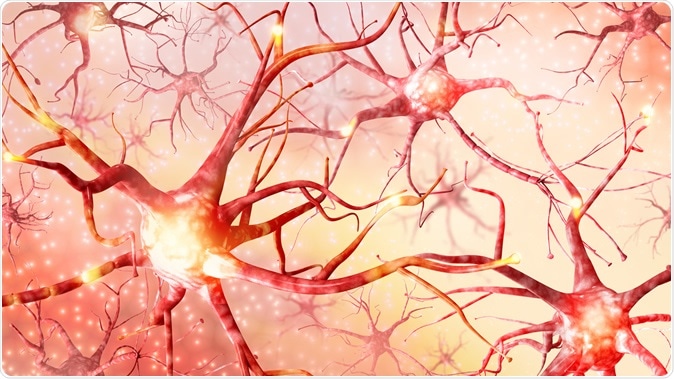Huntington’s disease is a genetic disease that is debilitating and progressive leading to severe brain damage and eventual death. In patients with this autosomal dominant disease, there is presence of a protein called the Huntingtin protein that forms clumps within the brain leading to the symptoms of the disease.
Researchers from the MIT have devised a way to perform a genetic screening that could help detect the genes that predict survival of the neurons. Their screening method has been extended to detect the genes causing the mutated protein huntingtin to form and damage the brain. The results of this new study have been published in the latest issue of the journal Neuron.

A genome-wide analysis has revealed genes that are essential for neuron survival, as well as genes that protect against the effects of Huntington’s disease. Image Credit: Romanova Natali / Shutterstock
According to the researchers, while the genes that cause the mutated protein to occur could be identified, it also gave rise to a drug target which if followed up could lead to a possible treatment for the deadly and incurable Huntington’s disease. Myriam Heiman, an associate professor of neuroscience in the Department of Brain and Cognitive Sciences, who led the study said, “These genes had never been linked to Huntington's disease processes before. When we saw them that was very exciting because we found not only one gene, but actually several of the same family, and also we saw them have an effect across two models of Huntington's disease.” She is also a member of MIT's Picower Institute for Learning and Memory and the Broad Institute of MIT and Harvard. Lead author of the study Mary Wertz is a post doctoral student at Broad Institute.
For this study the team looked at the genes coding for the proteins in mice brain. There were an array of around 22,000 genes, wrote the researchers. These genes could be screened for various neurological diseases, they explained. This included progressive neurological diseases such as Parkinsonism and Alzheimer’s disease said Heiman.
According to the team genetic screening is not new and has been performed routinely in animals and study subjects such as fruit flies, lab mice and worm C. elegans after knocking out certain key genes in them. These screening tests look at the ability of the lab subjects to survive after key genes have been removed from them. This was the first study that performed these tests on a mouse brain wrote the researchers. They added that this was challenging as genetic alterations are most complex within the brain. Heiman said in a statement, “These unbiased genetic screens are very powerful, but the technical difficulty of doing it in the central nervous system at a genome-wide scale has never been overcome.”
Before this study the team at Broad Institute has been working on genetic libraries of data that could be used to look at the results of removal of one or more genetic sequences. Finally they were ready with libraries that could selectively turn on or off any gene in the mice brain. They used a particular short hairpin RNA (shRNA) genetic library to look at messenger RNA which carries vital information for protein synthesis. They used CRISPR to delete or edit the genetic sequences and used viral carriers to carry within the cell the necessary altered genetic sequences.
The four or five shRNAs or CRISPR segments targeted each of the 22,000 mice brain genes using approximately 80,000 to 100,000 viruses to alter each of the brain cells within the mice. The viruses carrying the segments were taken in high concentration and injected within the brain in the striatum region and at least a quarter of all the brain cells received at least one of the shRNA or CRISPR elements. The striatum region was more of a target because it deals with the motor system of the body and helps in movement as well as cognitive functions and emotions. This area is not only affected by Huntington’s disease but also autism, Parkinsonism and drug addiction.
The mice were injected with viral carriers for seven months continuously after which the genetic makeup of the neurons of the stratum was checked. The neurons that needed the knocked out genes for survival would have died by the end of the study, explained the researchers. On the other hand if non-essential genes were knocked out, the neurons would be alive.
Results showed that several genes were important for the neurons to survive. This also yielded several genes vital for survival of the neurons but unknown in previous studies. Heiman said that they found certain genes that were not known earlier to be important. She added, “What we interpret this to mean is that neurons in the mammalian brain are much more metabolically active and have a much higher dependency on these processes than for example, a neuron in C. Elegans.”
They noted results in mice models that produced mutated form of the huntingtin protein. The screening of the normal mice was compared with those with Huntington's disease. If these mice contained less amounts of any shRNA or CRISPR elements, these could be deduced to be important targets that resisted the toxic effects of the huntingtin protein explained Heiman. The team found that drugs targeting the Nme1 gene could be one such target.
Heiman concluded, “This is very exciting to us because it's theoretically a druggable compound. If we can increase its activity with a small molecule, perhaps we can replicate the effect of genetic overexpression.”
This study was supported by the National Institutes of Health (NIH), National Institute of Neurological Disorders and Stroke (NINDS) and others.
Journal reference:
Genome-wide In Vivo CNS Screening Identifies Genes that Modify CNS Neuronal Survival and mHTT Toxicity Wertz, Mary H. et al. Neuro, https://www.cell.com/neuron/fulltext/S0896-6273(20)30004-0